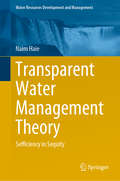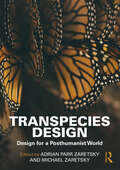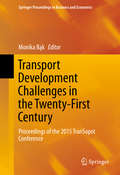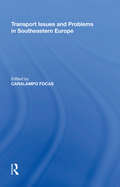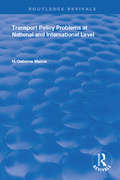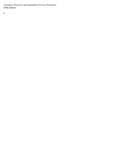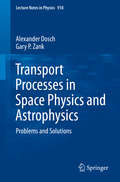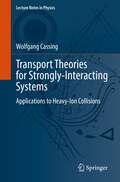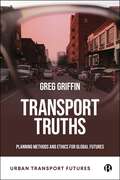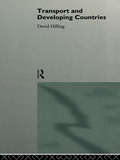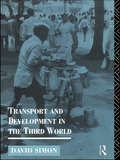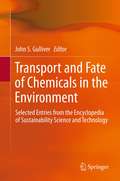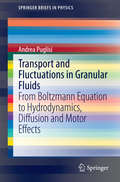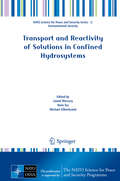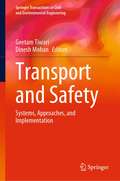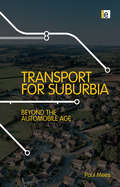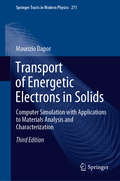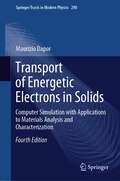- Table View
- List View
Transparent Water Management Theory: Sefficiency in Sequity (Water Resources Development and Management)
by Naim HaieThis book provides a solid foundation for a comprehensive, systemic and water-centric approach to water management. Said approach integrates two performance principles essential for sustainable water use systems, namely equity and efficiency. Further, it decreases the policy space for decision-making encountered by water managers and makes it easier to arrive at reasonable solutions because of the bounded rationality inherent in its development. By combining the distributive and aggregative principles, the approach offers a transparent and autonomous structure for gathering water data and enabling stakeholder involvement. Lastly, it employs and promotes a unifying language for all types of water use systems, e.g. urban, agricultural and industrial.
Transpecies Design: Design for a Posthumanist World
by Michael Zaretsky Adrian Parr ZaretskyIn May 2019, the United Nations released the Global Assessment Report on Biodiversity and Ecosystem Services which warned that human activities will drive nearly one million species to extinction in a few decades. The primary reasons for this are habitat loss and biodiversity demise caused by changing climate, pollution, introducing nonindigenous species, clearing land, over population, and consumption. Given this situation, humans must change course as both human wellbeing and the wellbeing of other-than-human species are imbricated in one another. One way humanity can accomplish the needed transformation is to move beyond an anthropocentric view of life by embracing a transpecies approach that is premised upon interconnected flourishing.Transpecies design, as outlined in this book, offers a new approach to regenerating the natural environment while honoring biodiversity. Rather than presenting the human experience as the goal of design, transpecies design takes the inextricable linkages connecting living things as both its starting point and end goal. As such, it moves beyond human experience serving as the fundamental ingredient for making better design processes and decisions.This book is essential reading for artists, designers, and architects, as well as students of architecture, landscape architecture, interior architecture, art, product design, urban design, planning, environmental philosophy, and cultural studies.
Transport Development Challenges in the Twenty-First Century
by Monika BąkThis volume explores the field of transport sector development. Derived from the 2015 TranSopot conference held in Sopot, Poland, it discusses current trends, issues, and research on the topic. Specifically, it aims to explore sustainable development, examines current problems ranging from transport systems to transport enterprises and provides a variety of analytical methods such as economic and econometric analysis. The three most important fields of current transport research are sustainable transport development, innovation and technological progress and the conditions of transport enterprise growth and survival. Transport is an activity which is supposed to be sustainable, environmentally aware, economically optimal, socially sound and politically responsible. Striving for innovation in transport means looking for organizational and technical solutions which increase the efficiency, effectiveness and safety of transportation. However, the main research issue in the field are strategies for sustainable transport developments in urban and rural areas, instruments of internalization of external transport costs, promotion of environmentally-friendly transport behavior and improvement of transport energy efficiency. Transport infrastructure innovation, intelligent transport systems, innovations in management and finance are some of the main concerns of researchers and policy-makers in the field. Transport enterprises need to adapt to the conditions of the new economic growth perspectives. They need to create unique growth conditions, otherwise they will condemn themselves to struggle for survival. In particular, transport enterprises have to create special functioning systems and programs to diversify economic activity to use funds in the most efficient ways possible.
Transport Efficiency and Safety in China (Population, Regional Development and Transport)
by Pengjun Zhao Liangen ZengThis book is the first comprehensive analysis of transport efficiency in China. It presents a series of rigorous empirical analysis for the operation and environmental efficiencies of major transport sectors, including highway, railway, civil aviation, and waterway. It also evaluates transport safety of China. The book innovatively employs a DEA model based on Epsilon measures (EBM) to evaluate transport efficiency and an EBM DEA model with undesirable outputs to calculate transport environmental efficiency. The factors of transport efficiency are quantitatively studied, including economic growth, social transition, and technology changes. Also, China's policies aimed at improving transportation efficiency are evaluated.The theoretical analyses and discussions would enhance our existing knowledge of the changes and determinants of transport system’s efficiency in a context of rapid urbanization, industrialization, and marketization in China. The findings of the existing policy evaluation would bring fresh evidences for transport policy performances to both scholars and politicians. In particular, it shows policymakers the experiences or lessons of how to create an efficient transport system in order to save energy use, reduce GHGs emissions, and improve social security. This book is of great interest to scholars interested in sustainable transport, regional planning and development, environmental policy and is relevant to China and other developing countries.
Transport Issues and Problems in Southeastern Europe
by Caralampo FocasThe collapse of previous command economic structures in Eastern Europe has led to an often chaotic reorganization of transport operations. Southeastern Europe in particular not only lags behind the western EU countries in terms of transport infrastructure, but also in terms of management and policy. However, despite this, or perhaps even because there are no long-standing established patterns, this region is a fertile territory for innovation. Based on the first major international conference dealing with transport issues in Southeastern Europe, this edited volume brings together key researchers and policy makers to discuss and critically analyse these innovations. Focusing on issues related to privatization and harmonization of national legislation, the contributors also address the countries' struggle with inadequate management structures and the challenges posed in running shipping, ports and railways in a region fragmented into numerous nations and states. It not only provides an up-to-date overview of transport operations and planning in Southeastern Europe, but also provides more general insights into recent and current developments in a region that has undergone widespread upheavals in the past two decades, and is now experiencing renewed growth.
Transport Moving to Climate Intelligence
by Werner Rothengatter Yoshitsugu Hayashi Wolfgang SchadeTransportation contributes to roughly a fifth of greenhouse gas emissions, and as a growing sector of the economy, its contribution to climate change, if remained unchanged, could even grow. This is particularly true in the developing world, where the growth rates of air and ship transport are expected to exceed those of the EU, and worldwide objectives to curb greenhouse gas emissions by 2050 by sixty to eighty percent could be placed in serious jeopardy. This book addresses the key issues of controlling transportation growth and identifying and implementing measures that would significantly reduce the emissions of greenhouse gases from transport while maintaining its vital role in generating prosperity and mobility for future generations. This book describes the challenge that transport constitutes today as well as its role in the future for climate policy. It will discuss and provide hands-on suggestions for transportation policy that will mitigate the greenhouse gas emissions from transport. The book is organized into five parts. Part One presents an overview of transport and climate policy in the context of the recent economic crisis. Part Two examines the problems and proposed solutions for curbing emissions from transport in industrialized countries while Parts Three and Four deal with the developing world, with a particular focus on India and China. Part Five discusses tested solutions and provides policy recommendations making this book of interest to a broad audience of both policy-makers and academics concerned with the role of transport in reducing global climate change.
Transport Policy Problems at National and International Level: A Contribution by the Transport Workers' Unions (Routledge Revivals)
by International Transport Worker's FederationPublished in 1959, this book presents a study of transport problems including those of the coordination of inland transport, and special problems of coordination in areas of urban transport, civil aviation, sea ports and arising problems in the course of the economic integration of Europe.
Transport Processes and Separation Process Principles (International Series in the Physical and Chemical Engineering Sciences)
by Christie Geankoplis Allen Hersel Daniel LepekTransport Processes and Separation Process Principles, Fifth Edition, offers a unified and up-to-date treatment of momentum, heat, and mass transfer and separations processes. This edition–reorganized and modularized for better readability and to align with modern chemical engineering curricula–covers both fundamental principles and practical applications, and is a key resource for chemical engineering students and professionals alike.
Transport Processes in Space Physics and Astrophysics
by Alexander Dosch Gary P. ZankThis is the problems and solution manual for the graduate text with the same title and published as Lecture Notes in Physics Vol 877 which provides the necessary mathematical and physics background to understand the transport of gases, charged particle gases, energetic charged particles, turbulence, and radiation in an astrophysical and space physics context. The very detailed and self-contained problems and solutions will be an essential part of the training of any graduate student wishing to enter and pursuing research in this field.
Transport Properties in Non-Equilibrium and Anomalous Systems
by Dario VillamainaThe study of fluctuations in statistical physics has a long history, and a general theory is well established, connecting fluctuations to response properties of equilibrium systems. Remarkably, this framework fails as soon as some current is flowing across the system, driving it out of equilibrium. The presence of currents is quite common in nature and produces rich phenomena which are far from being included in a general framework. This thesis focuses on this general problem by studying different models such as granular materials and systems exhibiting anomalous diffusion and shows how the generalized response techniques can be successfully used to catch the relevant degrees of freedom that drive the systems out of equilibrium. This study paves the way to the use of the generalized fluctuation relations in an operative way, in order to extract information from a non-equilibrium system and to build the corresponding phenomenological theory.
Transport Revolutions: Moving People and Freight Without Oil
by Richard Gilbert Anthony PearlTransport Revolutions: Moving People and Freight without Oil sets out the challenges to our growing dependence on transport fuelled by low-priced oil. These challenges include an early peak in world oil production and profound climate change resulting in part from oil use. It proposes responses to ensure effective, secure movement of people and goods in ways that make the best use of renewable sources of energy while minimizing environmental impacts. Transport Revolutions synthesizes engineering, economics, environment, organization, policy and technology, and draws extensively on current data to present important conclusions. The authors argue that land transport in the first half of the 21st century will feature at least two revolutions. One will involve the use of electric drives rather than internal combustion engines. Another will involve powering many of these drives directly from the electric grid - as trains and trolley buses are powered today - rather than from on-board fuel. They go on to discuss marine transport, whose future is less clear, and aviation, which could see the most dramatic breaks from current practice. With its expert analysis of the politics and business of transport, Transport Revolutions is essential reading for professionals and students in transport, energy, town planning and public policy.
Transport Systems, Policy and Planning: A Geographical Approach
by Rodney Tolley Brian John TurtonProvides a unique review of the major spatial aspects of transport systems, a detailed analysis of transport problems in urban and rural areas, an evaluation of social and environmental impacts, and a planning and policy overview. Divided into four parts, each considering a different aspect of transport geography. The first part outlines the basic geography of transport and examines transport and spatial structures, focusing upon the varying contributions made by transport to industrial, agricultural and urban development. Part two moves to consider specific transport systems at both national and international scales, drawing on studies from industrialised and developing nations and discussing the effects upon transport of the political changes in the former USSR and Eastern Europe. The third part examines some of the many problems of transport and urban and rural areas using specific examples to illustrate the contrasting difficulties and evaluate current urban transportation planning methods.
Transport Theories for Strongly-Interacting Systems: Applications to Heavy-Ion Collisions (Lecture Notes in Physics #989)
by Wolfgang CassingThis book provides an overview on transport theories, focusing on applications and the relativistic off-shell transport theory which are of particular interest for physicists working in the field of relativistic strong-interaction physics, e.g. relativistic or ultra-relativistic heavy-ion collisions or the evolution of the early universe. In this regard, a thorough derivation of the transport equations and a careful analysis of the approximations employed is given. The text is enriched with a multitude of Appendices that partly recall elements of quantum mechanics and field theory or present examples for specific models. Specific exercises are given throughout the chapters. As a basic knowledge the reader should be familiar with quantum mechanics and its principles as well as some basic concepts of the quantum many-body physics and field theory. All chapters close with a short summary and numerical calculations are provided to master and illustrate the subject.
Transport Truths: Planning Methods and Ethics for Global Futures (Urban Transport Futures)
by Greg P. GriffinIdeal for researchers and practitioners looking for fresh approaches to transport problems, this book combines cutting-edge qualitative and quantitative knowledge to inform transport futures. It uses engaging case studies of the Banjul Airport Expansion in The Gambia, and the Interstate 35 development project in Austin, US to show how and why a transdisciplinary approach can result in better planning decisions. As cities grow, shrink, and re-organize, with access provided by transport infrastructure, this book demonstrates the value of critical realism to create lasting, positive impacts on society and the environment.
Transport and Developing Countries
by Dr David Hilling David HillingImpassable roads, poorly maintained railways, bankrupt airlines, congested cities, and inefficient ports - are there links between these issues and lack of economic progress in developing countries? Inland waterways, ports, railways, roads, air and urban transport are all discussed and illustrated with examples of good and bad practice. The author explains how transport can only be effective if timing, location and technology are chosen carefully and if decisions are in the hands of the right parties.
Transport and Development in the Third World (Routledge Introductions to Development)
by David SimonIt is widely acknowledged that transport is a necessary condition for development to occur. Transport issues have become highly contentious and politicised. This volume presents a balanced review of transport provision and the development process in the Third World. Providing a comprehensive survey of the range of transport modes and forms utilised in rural, urban and international contexts, the book examines the development implications of such choices, together with appropriate policies to address transport problems in the Developing World. This is a stimulating and provocative text. Its distinctive structure and logic challenge conventional wisdoms, and raise key issues seldom addressed in transport courses.
Transport and Fate of Chemicals in the Environment
by John S. GulliverWhat happens when a chemical is released into the environment? It diffuses, disperses, adsorbs, reacts, and/or changes state. To predict and analyze this process, the mathematics of diffusion is applied to lakes, rivers, groundwater, the atmosphere, the oceans, and transport between these media. A sustainable world requires a deep understanding of the transport of chemicals through the environment and how to address and harness this process. This volume presents a succinct and in-depth introduction to this critical topic. Featuring authoritative, peer-reviewed articles from the Encyclopedia of Sustainability Science and Technology, Transport and Fate of Chemicals in the Environment represents an essential one-stop reference for an audience of researchers, undergraduate and graduate students, and industry professionals.
Transport and Fluctuations in Granular Fluids
by Andrea PuglisiThis brief offers a concise presentation of granular fluids from the point of view of non-equilibrium statistical physics. The emphasis is on fluctuations, which can be large in granular fluids due to the small system size (the number of grains is many orders of magnitude smaller than in molecular fluids). Firstly, readers will be introduced to the most intriguing experiments on fluidized granular fluids. Then granular fluid theory, which goes through increasing levels of coarse-graining and emerging collective phenomena, is described. Problems and questions are initially posed at the level of kinetic theory, which describes particle densities in full or reduced phase-space. Some answers become clear through hydrodynamics, which describes the evolution of slowly evolving fields. Granular fluctuating hydrodynamics, which builds a bridge to the most recent results in non-equilibrium statistical mechanics, is also introduced. Further and more interesting answers come when the dynamics of a massive intruder are discussed. Such non-equilibrium stochastic process offers a more precise and compact picture of the features foreseen at the more detailed levels of description. The dynamics of an intruder diffusing in a granular fluid reveal the clearest connection with recent theories on stochastic energetics and stochastic thermodynamics.
Transport and Reactivity of Solutions in Confined Hydrosystems
by Lionel Mercury Niels Tas Michael ZilberbrandThe present work reflects a multi-disciplinary effort to address the topic of confined hydrosystems developed with a cross-fertilization panel of physics, chemists, biologists, soil and earth scientists. Confined hydrosystems include all situations in natural settings wherein the extent of the liquid phase is limited so that the solid-liquid and/or liquid-air interfaces may be critical to the properties of the whole system. Primarily, this so-called "residual" solution is occluded in pores/channels in such a way that decreases its tendency to evaporation, and makes it long-lasting in arid (Earth deserts) and hyper-arid (Mars soils) areas. The associated physics is available from domains like capillarity, adsorption and wetting, and surface forces. However, many processes are still to understand due to the close relationship between local structure and matter properties, the subtle interplay between the host and the guest, the complex intermingling among static reactivity and migration pathway. Expert contributors from Israel, Russia, Europe and US discuss the behaviour of water and aqueous solutes at different scale, from the nanometric range of carbon nanotubes and nanofluidics to the regional scale of aquifers reactive flow in sedimentary basins. This scientific scope allowed the group of participants with very different background to tackle the confinement topic at different scales. The book is organized according to four sections that include: i) flow, from nano- to mega-scale; ii) ions, hydration and transport; iii) in-pores/channels cavitation; iv) crystallization under confinement. Most of contributions relates to experimental works at different resolution, interpreted through classic thermodynamics and intermolecular forces. Simulation techniques are used to explore the atomic scale of interfaces and the migration in the thinnest angstrom-wide channels.
Transport and Safety: Systems, Approaches, and Implementation (Springer Transactions in Civil and Environmental Engineering)
by Geetam Tiwari Dinesh MohanThis volume addresses a variety of issues on traffic safety policy, ranging from issues of climate change, urban equity, and transport safety, in a broad global and societal context, while retaining situation-specific details. Written by international experts on issues of transportation and traffic safety, it will be of special interest to advanced researchers in the engineering and planning disciplines working on these issues as well as policy makers concerned with setting up institutions and legislations for traffic safety.
Transport by Pipelines and Its Optimization: A Sustainable Approach to the Design (Petroleum Engineering)
by Pablo Druetta Remo Frabotta Gustavo Luis CavalloThis textbook introduces pipeline design, one of the most efficient techniques for mass and energy transport available today. The global economy heavily relies on pipelines. However, designing a pipeline is more complex than it might seem; it involves many technical and economic factors that must work together to create an optimized system. The book begins with basic concepts of pipelines, including a description of the materials used, heat transfer between the system and medium, and the main components of pumping and compression stations, which are vital for the subsequent chapters. It then presents a simple yet detailed overview of these factors and introduces a mathematical methodology that combines them to deliver an optimized pipe design, minimizing costs and reducing energy consumption. The book also covers the transient verification of this design using well-known balance equations and material property relationships for both incompressible and compressible fluids, to validate the initial design. Finally, the book explores the analysis of multiphase pipelines, where the goal is to transport a particular material (e.g., solid) using a different medium (e.g., air or water).
Transport for Suburbia: Beyond the Automobile Age
by Paul MeesThe need for effective public transport is greater than ever in the 21st century. With countries like China and India moving towards mass-automobility, we face the prospects of an environmental and urban health disaster unless alternatives are found. It is time to move beyond the automobile age. But while public transport has worked well in the dense cores of some big cities, the problem is that most residents of developed countries now live in dispersed suburbs and smaller cities and towns. These places usually have little or no public transport, and most transport commentators have given up on the task of changing this: it all seems too hard. This book argues that the secret of 'European-style' public transport lies in a generalizable model of network planning that has worked in places as diverse as rural Switzerland, the Brazilian city of Curitiba and the Canadian cities of Toronto and Vancouver. It shows how this model can be adapted to suburban, exurban and even rural areas to provide a genuine alternative to the car, and outlines the governance, funding and service planning policies that underpin the success of the world's best public transport systems.
Transport in the Atmosphere-Vegetation-Soil Continuum
by Arnold F. Moene Jos C. van DamTraditionally, soil science, atmospheric science, hydrology, plant science and agriculture have been studied largely as separate subjects. These systems are clearly interlinked, however, and in recent years a great deal of interdisciplinary research has been undertaken to better understand the interactions. This textbook was developed from a course that the authors have been teaching for many years on atmosphere-vegetation-soil interactions at one of the leading international research institutes in environmental science and agriculture. The book describes the atmosphere-vegetation-soil continuum from the perspective of several interrelated disciplines, integrated into one textbook. The text is interspersed with many student exercises and problems, with solutions included. It will be ideal for intermediate to advanced students in meteorology, hydrology, soil science, environmental sciences and biology who are studying the atmosphere-vegetation-soil continuum, as well as researchers and professionals interested in the observation and modelling of atmosphere-vegetation-soil interactions.
Transport of Energetic Electrons in Solids: Computer Simulation with Applications to Materials Analysis and Characterization (Springer Tracts in Modern Physics #271)
by Maurizio DaporThis book describes, as simply as possible, the mechanisms of scattering (both elastic and inelastic) of electrons with solid targets (electron–atom, electron–plasmon, and electron–phonon interactions). It also presents the main strategies of the Monte Carlo method, as well as numerous comparisons between simulation results and the experimental data available in the literature. Furthermore it provides readers with all the information they need in order to write their own Monte Carlo code and to compare the obtained results with the many numerical and experimental examples presented throughout the book. An extended and updated third edition of a work published in 2014 (first edition) and in 2017 (second edition) on the application of the Monte Carlo method to the transport of fast electrons in solids, this book includes, as novel topics, the theory of polarized electron beams (i.e. density matrix and spin polarization), the study of elastic scattering by molecules, a classical treatment of the Bethe-Bloch stopping power, a simple derivation of the f- and ps-sum rules, the Vicanek and Urbassek formula for the calculation of the backscattering coefficient, the Wolff theory describing the secondary electron spectra, and fundamental aspects of the interactions between electrons beams and solid targets. Further, it describes a completely analytical approach (the so-called multiple reflection method) for calculating the absorbed, backscattered, and transmitted fractions of electrons from unsupported and supported thin films. It also discusses recent applications of the Monte Carlo method.
Transport of Energetic Electrons in Solids: Computer Simulation with Applications to Materials Analysis and Characterization (Springer Tracts in Modern Physics #290)
by Maurizio DaporThis book describes the computational methods most frequently used to deal with the interaction of charged particles, notably electrons, with condensed matter. Both elastic and inelastic scattering phenomena are discussed, and methods for calculating the relevant cross sections are explained in a rigorous but simple way. It provides readers with all the information they need in order to write their own Monte Carlo code and to simulate the transport of fast particles in condensed matter. Many numerical and experimental examples are presented throughout the book.The updated and extended fourth edition features ab initio methods for calculating dielectric function and energy loss function. Non-relativistic partial wave expansion method for calculating the differential elastic scattering cross section is also included in this new edition. It represents a very useful introduction to the relativistic partial wave expansion method, i.e., to the Mott theory, already discussed in the previous editions of this book. Further details about the effects of spin-polarization on the differential elastic scattering cross section are included in this new edition. The multiple reflection method is extended to the general case of a system composed of a set of layers of different materials and thicknesses. Analytical expressions are provided for calculating the backscattering coefficient of multilayers. New results are presented, notably about Monte Carlo simulations of reflection electron energy loss spectra and of the radial dose deposited along the track of ions impinging on materials.
